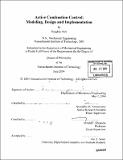| dc.contributor.advisor | Anuradha M. Annaswamy. | en_US |
| dc.contributor.author | Park, Sungbae, 1973- | en_US |
| dc.contributor.other | Massachusetts Institute of Technology. Dept. of Mechanical Engineering. | en_US |
| dc.date.accessioned | 2005-09-06T21:46:37Z | |
| dc.date.available | 2005-09-06T21:46:37Z | |
| dc.date.copyright | 2004 | en_US |
| dc.date.issued | 2004 | en_US |
| dc.identifier.uri | http://hdl.handle.net/1721.1/27107 | |
| dc.description | Thesis (Ph. D.)--Massachusetts Institute of Technology, Dept. of Mechanical Engineering, 2004. | en_US |
| dc.description | Includes bibliographical references (leaves 111-116). | en_US |
| dc.description.abstract | Continuous combustion systems common in propulsion and power generation applications are susceptible to thermoacoustic instability, which occurs under lean burn conditions close to the flammability where most emissions and efficiency benefits are achieved, and near stoichiometry where often high power density can be realized. This instability is undesirable because the accompanying large pressure and heat release rate oscillations lead to high levels of acoustic noise and vibration as well as structural damage. Active control is one approach using which such instabilities can be mitigated. Over the past five to ten years, it has been shown conclusively through several lab-scale studies that active control is highly successful in suppressing the pressure oscillations. This success has set the stage for transition of the technology from laboratories to large-scale applications in propulsion and power generation. This thesis provides some of the building blocks for enabling this transition. The first building block concerns the modeling of hydrodynamics and its interactions with the other components that contribute to combustion dynamics. The second is the impact of active control on emissions even while suppressing the pressure instability. The third is the evaluation of model-based active controllers in realistic combustors with configurations that include swirl, large convective delays and unknown changes in the operating conditions. The above three building blocks are investigated in the thesis experimentally in three different configurations. The first is a 2D backward facing step combustor, constructed at MIT, with the goal of investigating the flame-vortex interactions and the impact of active control on emissions. The second | en_US |
| dc.description.abstract | (cont.) is a dump combustor, constructed at University of Maryland, so as to reproduce more realistic ramjet conditions. The third is an industrial swirl-stabilized combustor, constructed at University of Cambridge, to mimic realistic industrial gas combustor configurations which typically include large convective time delays, swirl, and on-line changes in the operating conditions. Results obtained from these three configurations show that through an understanding of the underlying physics and reduced-order modeling, one can design an appropriate actuation, sensing and control algorithm, all of which lead to model-based active control that reduces pressure oscillations to background noise. | en_US |
| dc.description.statementofresponsibility | by Sungbae Park. | en_US |
| dc.format.extent | 116 leaves | en_US |
| dc.format.extent | 5264220 bytes | |
| dc.format.extent | 5278232 bytes | |
| dc.format.mimetype | application/pdf | |
| dc.format.mimetype | application/pdf | |
| dc.language.iso | en_US | |
| dc.publisher | Massachusetts Institute of Technology | en_US |
| dc.rights | M.I.T. theses are protected by copyright. They may be viewed from this source for any purpose, but reproduction or distribution in any format is prohibited without written permission. See provided URL for inquiries about permission. | en_US |
| dc.rights.uri | http://dspace.mit.edu/handle/1721.1/7582 | |
| dc.subject | Mechanical Engineering. | en_US |
| dc.title | Active combustion control : modeling, design and implementation | en_US |
| dc.type | Thesis | en_US |
| dc.description.degree | Ph.D. | en_US |
| dc.contributor.department | Massachusetts Institute of Technology. Department of Mechanical Engineering | |
| dc.identifier.oclc | 56836335 | en_US |
